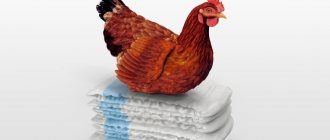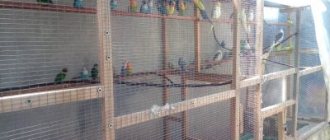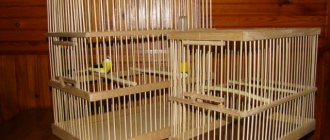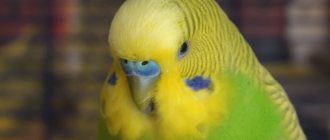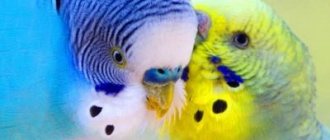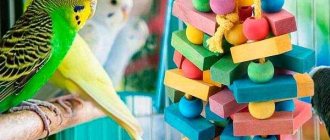Varieties
Pet stores offer a huge number of toys made from various materials and designed for wavy animals. They can be used inside or outside the cage and have different functions.
Some things are needed to sharpen the beak and nails, while others develop intelligence. There must be toys designed for the full physical development of the pet.
Before purchasing a finished product, it is important to make sure that there are no glue residues or small objects on the surfaces that the parrot could tear off and swallow.
For sharpening the beak
The beak of the wavy is covered on top with a horny layer, which is easily ground off.
To do this, the parrot must have constant access to special objects that are used to sharpen its beak. You can use special toys made of wood or plastic.
The basic rule to follow is the safety of the material used. Typically, such toys are represented by a dummy bird, wooden sticks attached to the wall of the cage, as well as perches with unusual protrusions.
Intelligent
Their purpose is to develop the mental abilities of the bird. They are represented by special educational puzzles, upon solving which the bird gains access to some kind of delicacy.
Usually labyrinths or special balls are used for these purposes , which are closed on several sides, but have recesses into which the wavy can insert its beak. With regular use of such toys, the pet becomes more intelligent, and this often has a positive effect on the speed of speech learning.
Do you buy toys for your parrot?
Not really
For physical development
Since pet parrots don't move much, they require special items to help them maintain optimal physical condition. For this purpose, special rings, perches, bungees and ladders are used.
But it is not recommended to overdo it with these elements, since otherwise the parrot simply will not have room for quiet rest and relaxation. You need to place purchased or made elements at different heights.
Interactive
They consist in the fact that the bird must perform certain actions in order to receive a certain delicacy. Sometimes such toys produce sounds when pressed, which arouses the parrot's interest.
Some birds do not understand what needs to be done with an interactive toy, so the human task is to show the principle of operation of the item.
Toys for large parrots
Macaws, Grays, Kakapos, and Amazons are representatives of large breeds. The size of the bird influences the choice of toys. The birds' beak is so powerful that it can crack a nut. Your belongings will be gutted or chewed. Offer your pet chewing toys made from hard wood, use any branches.
The intelligence of birds is equal to a child of five years old. It is important to develop mental abilities. An excellent option is forage bags. These are puzzle toys where the parrot needs to get food.
Buy products intended for small children. All sorts of cubes, rattles, rings will suit the parrot in size, he will be able to hold them perfectly with his paw or beak.
Variety of options
They are intended not only for budgerigars, but also for other types of parrots. When choosing, it is advisable to focus on the size of the pet.
Only bright and colorful objects are selected that make an unusual noise or melody during use.
Active birds actively react to such objects, so they play with pleasure with elements that ring, squeak or rustle.
Since the wavy birds are represented by small birds, toys of the appropriate size are selected for them.
Various bells, beads, ladders, rattles, and beads are ideal. Such things distract the bird for a long time, and they can be placed not only inside the cage.
If the parrot is afraid to go outside, then you can attract him with toys, after which the pet quickly gets used to the fact that he is not in any danger outside the cage.
Diggers
Birds in the wild spend a lot of time searching for food. They can rummage in the ground for hours, sorting through leaves, twigs and fragments of bark. The wavy not only get enough food, but also have a great time.
Individuals living at home are often bored and do not know how to have an interesting time. Therefore, special pickers are considered the ideal choice. You can make them with your own hands, for which you use a not too deep container, which is filled with various rustling objects. The mower itself can be installed on the bottom of the cage.
For filling, various plant and safe waste is used, represented by twigs, pieces of bark, nut shells, cones, dry leaves, berries, orange zest or lumps of clay.
It is even possible to make edible scoops, for which pieces of dried fruit, carrot slices or sickles are added, so the more items there are in the container, the more interesting the pastime will be for the bird.
Swing
They are sold in different sizes, so you need to choose products that match the size of your pet. To make it interesting and pleasant for the bird to communicate , it is recommended to choose models equipped with different beads or other decorations.
You can make a swing with your own hands, for which you make a triangular base from wire. A wooden perch or tube with a hole for wire is attached to the bottom.
Bells
Wavy animals love to play with them, as the toy makes an unusual and loud sound. You can buy one bell or make a large toy from several elements. Pet stores offer bells in different sizes, colors and shapes.
A bell, beads and twigs are strung on a rope, which allows you to get an original toy that is fixed to the top of the cage.
Ladders
They delight any wavy bird, so some birds can spend hours climbing up and down such a ladder. They are made from wood, plastic and other materials.
They are very easy to make on your own , for which you use poles of the same size. They are connected to each other with high-quality and durable rope. A small indentation is made at the end of each pole to allow the rope to be securely fastened. Before hanging the product, the wooden parts are sanded and also tied.
Rope
They are often large in size, so they do not always fit inside the cage. Therefore, it is advisable to use them indoors where the parrot has free access. Hooks are attached to the wall, with twisted ropes stretched between them.
The ropes have bright colors that attract birds.
Foragers
In another way, they are called food toys, and can also be used by both wavy birds and cockatiels or macaws. Their main purpose is the intellectual development of the bird, and you can choose forages of different levels of complexity.
You can make such a toy from a coconut, which is divided into two parts, which are cleared of pulp. Next, they are connected using a wooden stick. The parrot's favorite treats are placed inside. The bird's job is to figure out how to get the treat.
Musical toys
They are represented by bells or rattles. Pet stores sell special items that produce an unusual melody. They are usually equipped with bright buttons that parrots enjoy pressing. Birds quickly understand that if you press this or that button, an interesting sound will appear.
Typically, such toys are used when teaching a parrot to speak, since if a parrot often hears one melody, it will quickly be able to reproduce it.
Game complexes
They are presented as complete complexes for parrots. The platforms do not fit in the cage, so they are installed next to it. Such stands are suitable for parrots that spend a lot of time outside the cage.
The sites consist of several tiers that are connected to each other . They are fixed with swings, ropes, branches, wires, ropes and chains. A parrot can do a variety of physical activities. The complexes can be decorated with additional elements to diversify your pet’s leisure time.
Mirrors
The wavy birds are represented by proud birds who admire themselves with pleasure.
Therefore, they respond well to the mirror, regularly communicating and flirting with the reflection. If there is only one wavy living in the cage, then it is advisable to attach a mirror to the wall.
But if a couple lives in the same area, then it is recommended to abandon mirrors.
The same decision is made by people who pay a lot of attention to the bird and also want to quickly teach it to talk.
Some ornithologists claim that the mirror, due to its mercury content, can cause serious harm to the health of the parrot.
Rules for selecting items for the game
The toy can be bought at any pet store, but some rules are taken into account:
- All items are disinfected after purchase and only then provided to the wavy;
- toys are selected that do not contain very small objects, for example, beads or small beads, since the parrot can tear them off and swallow them;
- It is undesirable to choose cheap plastic products, since the wavy quickly chews them up, and plastic particles can get into the stomach and intestines;
- you cannot buy wooden toys made from pear, bird cherry or oak branches;
- It is prohibited to use elements made of aluminum, brass or zinc;
- if you buy products made from threads, then it is advisable to choose linen, jute or cotton, but as soon as the parrot frays them, they need to be thrown away;
- models are selected without sharp corners that could injure the bird;
- It is not allowed to have holes in which a bird's beak can get stuck.
It is forbidden to use painted toys, as paint particles enter the stomach during play, causing poisoning.
In the photo there are options for toys for budgies:
Harmless materials
Bird cherry, oak and pear branches are not suitable for making homemade toys for budgies and other parrots. It is also not recommended to use poplar wood. The pet will definitely taste the tree, and this can have a bad effect on its health.
It is better to stay on the branches of fruit trees. Before making anything, they need to be boiled.
When it comes to metals, you should not buy aluminum, brass, or zinc toys. Like unsuitable wood, they can harm your parrot's health.
Mechanical fastenings and hooks must also be secure.
Parrots love play accessories made from thread. It is better to take from linen, sesal, jute, cotton, etc. As soon as they become disheveled, they must either be replaced with new ones or completely removed from the cage.
Can plants be play?
Some plants are useful not only for eating, but also for creating interesting toys. But such structures are quickly eaten, so only healthy and safe plants are chosen to create the toy.
Willow wreaths are often made by joining willow branches with strong wire . You can even leave leaves that are of interest to the birds. To decorate such a wreath, you can use small flowers, bells and beads.
Edible toys made from healthy greens are not only attractive, but also useful. But it is important to choose plants wisely, as some herbs are dangerous for parrots.
How to make it yourself
You can make different types of toys yourself that you can play with. To do this, you do not need to use specialized tools or expensive materials. In just a few minutes you can get a product decorated with bells, ropes or beads.
The most popular are swings, which are made based on the size of the wavy.
To create them, follow these steps:
a wooden branch for the perch is cut, and the length varies from 7 to 15 cm, but the individual size of the bird is taken into account;- small cuts are made on both sides of the stick, which will allow the thread to be securely fastened;
- two jute threads are tied to the perch, which are inserted into pre-made cuts, and the length of the thread depends on the height of the cage;
- The finished swing is suspended inside the cage using a thread.
When choosing the diameter of the perch, it is taken into account that the bird should cover ¾ of it with lamps, and not completely.
In the video, one of the options for creating entertainment for wavy animals:
Materials for production
To make a swing, you just need to prepare a perch . It can be bought or made from a wooden twig, which is turned and sanded. It is fixed with a strong jute thread.
To obtain a beautiful design, it is advisable to prepare decorations, for example, multi-colored threads tied into a bundle, a bell or beads.
Tools
The following elements are required for operation:
- sanding paper for processing wooden perches;
- scissors for cutting threads and branches.
The procedure for creating a structure does not take more than 30 minutes.
Important Tips
Having figured out how to play and communicate with a budgie, it is not enough to provide your pet with a variety of devices. Following these tips will help you care for your bird:
- It is better to purchase those toys that are intended specifically for “wavy children”;
- When making homemade toys, it is worth remembering that they must correspond to the size of the bird;
- a parrot needs variety, and therefore toys must be replaced periodically with others;
- the pet’s home should be as spacious as possible, and therefore you should not “clutter it up” with play equipment; it is better to make a play area;
- the safety of the pet when placing toys is paramount;
- play equipment must be washed and cleaned;
- broken items should be removed from the pet’s field of vision as quickly as possible.
When caring for your feathered friend, it is important to promote his physical and psychological comfort. Established contact will make the bird the owner’s best friend, with whom you can even have a heart-to-heart talk. Joint games will allow you to make friends and tame the bird so much that it will not accept anyone else as its owner.
Rules for placement inside the cage
Some owners get lost when choosing items to entertain the bird, so they buy too many items and cover the inside of the cage with them. This leads to the fact that the wavy cannot move freely, which creates serious discomfort.
Therefore, the following rules are taken into account:
- toys should not restrict the pet’s movements;
- Only elements that are truly interesting to the parrot are selected, so if an item is never used by the pet, then it is advisable to remove it;
- in the center there remains a place thanks to which the bird can jump from perch to perch;
- all toys are attached to the walls or ceiling of the cage.
If you have a large cage, you can organize a kind of play area in it, leaving plenty of space for walking and sleeping.
Is it necessary to accustom a bird to objects?
Wavy birds are inquisitive birds, but at the same time they are often frightened by new objects. Therefore, young individuals have to be taught to play. The bird gradually gets acquainted with new entertainments, and you can also reward your pet with treats.
First, the owner must show the toy from his hands, and only after the wavy begins to show interest, it is placed inside the cage. Each bird has its own preferences, so the interior decoration of the cage is formed based on them. It is not advisable to force a pet if it is not interested in a particular subject.
Homemade devices
Often the parrot shows interest in homemade rope ladders, wooden walkways, steps, and swings. Their turn comes when purchased products become boring and no longer attract the feathered fidget. You can make new toys yourself.
How to choose materials to create fun gadgets
Budgerigars are susceptible to limb injuries and poisoning, so the materials from which toys for him will be made must be safe.
The following materials cannot be used:
- Cotton. It crumbles easily, and the bird can get entangled in the threads or swallow some of them. This leads to blockage of the esophagus and the death of the feathered pet.
- Metal products made of brass, copper, zinc. They are toxic to budgies. Also, you cannot use scraps of chains and dismountable metal products with small parts.
- All non-fruit tree species. They are often toxic to poultry. Apple, cherry, plum, and oak are suitable for making toys for a parrot.
On a note! It is prohibited to coat the finished product with paint and varnish products.
